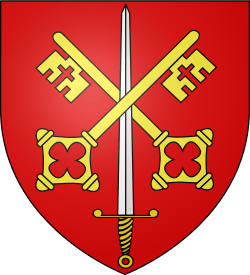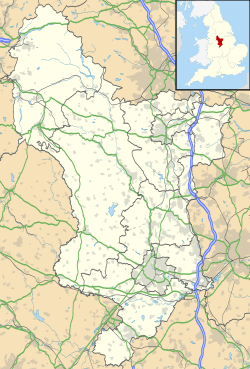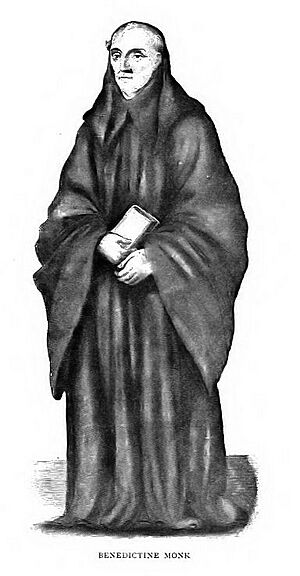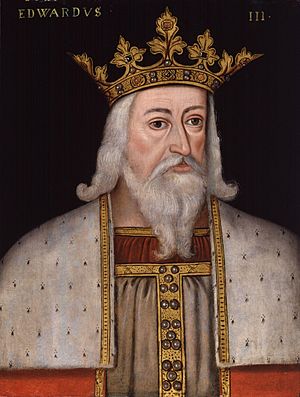St. James Priory, Derby facts for kids

Coat of Arms of Cluny Abbey
|
|
| Monastery information | |
|---|---|
| Full name | St James' Priory, Derby |
| Other names | Prioratus Sancti Jacobi de Derby de Aldenna |
| Order | Benedictine: Cluniac order |
| Established | Between 1072-1076 |
| Disestablished | 1536 |
| Mother house | Bermondsey Abbey Cluny Abbey |
| Dedicated to | St James |
| Diocese | Diocese of Lichfield |
| People | |
| Founder(s) | Waltheof, Earl of Northumbria |
| Site | |
| Location | St James's Street (formerly St James's Lane), Derby |
| Coordinates | 52°55′20″N 1°28′42″W / 52.922323°N 1.478444°W |
| Grid reference | SK 3517 3624 |
| Visible remains | None |
St. James Priory, also known as Derby Cluniac Priory, was a Benedictine monastery. It was once located in what is now Derby City Centre. This priory was a home for monks until the Dissolution of the Monasteries in the 1500s.
Contents
History of the Priory
How the Priory Started
The priory was built on the north side of St James's Street, which used to be called St James's Lane. It was right next to the Markeaton Brook.
Before the priory, there was a small church dedicated to St James on this spot. This church dated back to the Saxon era (a long time ago in English history).
Between 1072 and 1076, a powerful nobleman named Waltheof, Earl of Huntingdon and Northumbria, gave this chapel to the Benedictine monks from Bermondsey Abbey. The monks quickly turned the chapel into a priory, which is a type of monastery. King Stephen later confirmed this gift around 1140.
The local government of Derby, known as the Corporation of Derby, paid the priory a small amount of wax each year. This payment was so that people in Derby could use St James Bridge, which the monks had built.
Life in the 1200s
In the 1200s, the priory opened a hospital. This hospital helped "the poor and unwell" people in the area. Around 1230, King Henry III officially recognized the priory as a "poor hospital," meaning it helped those in need.
In 1279, the head of the Cluny Abbey, Yves de Chassant, ordered that all Cluniac monasteries in England be checked. When St James' Priory was inspected, it had a prior (the head monk) and two other monks. The prior was described as a "worth good man." One monk was also praised, but the other was "living disreputably." This monk was sent away to Bermondsey Abbey for punishment.
The inspectors also noted that the priory buildings were in good shape, except for the church's roof. They also found that the priory owed £4 10s, which was a debt at the time. In 1291, records showed the priory had a yearly income of £5 8s 4d, which was considered "slenderly endowed," meaning it didn't have much money.
Challenges in the 1300s
On September 14, 1330, King Edward III gave the priory special protection for one year. Kings often did this for monasteries that were having money problems.
Just five years later, in 1335, a big accident happened. The priory, its church, and the hospital all burned down. The King again gave them protection, this time for two years. This allowed the priory to collect donations from churches to raise money for rebuilding.
During the Hundred Years' War (a long war between England and France), King Edward III took control of many French-owned monasteries in England. St James' Priory was linked to a French monastery, but it was initially allowed to keep its land. This was because its main monastery, Bermondsey Abbey, claimed to be from Burgundy, not France.
However, the King still made the priory pay 100 shillings a year to the Crown. The prior also had to pay an extra 50 shillings to keep control of the priory. If they didn't pay, the King's officers would take their goods or even the prior to London.
In May 1338, King Edward III changed his mind. Because the priory was so poor, he stopped asking for the 100 shillings each year. But he also ordered that all the priory's lands be taken over by the Crown. The prior was excused from his personal payment as long as the priory remained under the King's control.
Changes in the 1400s
In 1400, Bermondsey Abbey, the mother house of St James' Priory, was given a special status called "denization." This meant it was no longer seen as a foreign monastery, even though it wasn't fully English. Because of this, St James' Priory also gained the same status.
This change meant St James' Priory was not shut down like other foreign monasteries. It also stopped sending money to the French Cluny Abbey. Some records suggest St James Priory became independent from Bermondsey Abbey even earlier, in 1395.
The Priory's Income in the 1500s
In 1532, records show the priory had a yearly income of £11 15s 11d. This money came from various sources:
- 10 shillings from Lenton Priory for land in Duston.
- 2 shillings from Lilleshall Abbey for land at Blackfordby.
- 12 pence from the master of Burton Lazars.
- 12 pence from "master Anthony Babyngton."
The priory also earned money from land in the Charnwood Forest, where they had a corn mill and a walk mill (a mill powered by people or animals walking) on the River Soar.
The End of the Priory
Dissolution and What Happened Next
The last prior (head monk) of St James' Priory was Thomas Gainsbury. When the priory was closed down during the Dissolution of the Monasteries, he was given a pension of £7 each year.
After the priory closed, the "Free Chapel of St. James, with all the lands" was given to the Corporation of Derby (the local government).
What's Left Today?
Sadly, there are no visible remains of St James' Priory today. The area where it stood, St James's Street, is in the city centre and has been built on many times since the priory closed. Because of all this new construction, we don't know the exact spot where the priory once stood.
In 1829, people reported that the King's Head Inn was on the site where the priory used to be.
Artifacts Over the years, some interesting items have been found at the site. These include a large key, human remains, and a special grave slab with carvings on it.
|




